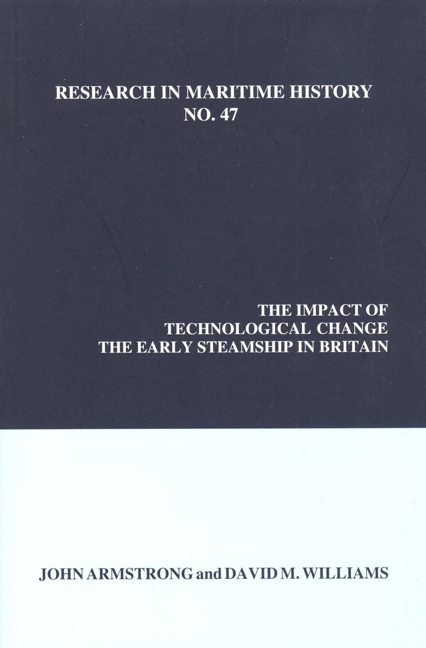Book contents
- Frontmatter
- Contents
- Series Editor's Foreword
- About the Authors
- Introduction
- Chapter 1 British Steam Navigation, 1812 to the 1850s: A Bibliographical and Historiographical Review
- Chapter 2 Some Official Listings of “Vessels Navigated by Steam” in Britain up to 1851: Evidence and Interpretation
- Chapter 3 The Steamboat, Safety and the State: Government Reaction to New Technology in a Period of Laissez-Faire
- Chapter 4 The Steamboat and Popular Tourism
- Chapter 5 The Thames and Recreation, 1815-1840
- Chapter 6 Steam Shipping and the Beginnings of Overseas Tourism: British Travel to North Western Europe, 1820-1850
- Chapter 7 Technological Advance and Innovation: The Diffusion of the Early Steamship in the United Kingdom, 1812-1834
- Chapter 8 The Steamship as an Agent of Modernisation, 1812-1840
- Chapter 9 “A New and Very Modern Business:” The Traffic and Operations of the Early Steamship
- Chapter 10 Promotion, Speculation and Their Outcome: The “Steamship Mania” of 1824-1825
- Chapter 11 The Perception and Understanding of New Technology: A Failed Attempt to Establish Transatlantic Steamship Liner Services, 1824-1828
- Chapter 12 The “Norwich Explosion” of 1817: A Local Tragedy of National Significance
- Chapter 13 Early Steamboat Services and Their Impact in North Wales, 1817-1840s
- Chapter 14 The Beginnings of a New Technology: The Constructors of Early Steamboats, 1812-1822
Chapter 3 - The Steamboat, Safety and the State: Government Reaction to New Technology in a Period of Laissez-Faire
- Frontmatter
- Contents
- Series Editor's Foreword
- About the Authors
- Introduction
- Chapter 1 British Steam Navigation, 1812 to the 1850s: A Bibliographical and Historiographical Review
- Chapter 2 Some Official Listings of “Vessels Navigated by Steam” in Britain up to 1851: Evidence and Interpretation
- Chapter 3 The Steamboat, Safety and the State: Government Reaction to New Technology in a Period of Laissez-Faire
- Chapter 4 The Steamboat and Popular Tourism
- Chapter 5 The Thames and Recreation, 1815-1840
- Chapter 6 Steam Shipping and the Beginnings of Overseas Tourism: British Travel to North Western Europe, 1820-1850
- Chapter 7 Technological Advance and Innovation: The Diffusion of the Early Steamship in the United Kingdom, 1812-1834
- Chapter 8 The Steamship as an Agent of Modernisation, 1812-1840
- Chapter 9 “A New and Very Modern Business:” The Traffic and Operations of the Early Steamship
- Chapter 10 Promotion, Speculation and Their Outcome: The “Steamship Mania” of 1824-1825
- Chapter 11 The Perception and Understanding of New Technology: A Failed Attempt to Establish Transatlantic Steamship Liner Services, 1824-1828
- Chapter 12 The “Norwich Explosion” of 1817: A Local Tragedy of National Significance
- Chapter 13 Early Steamboat Services and Their Impact in North Wales, 1817-1840s
- Chapter 14 The Beginnings of a New Technology: The Constructors of Early Steamboats, 1812-1822
Summary
The history of steam power and its application to water transport is generally well-tilled ground. It is commonly agreed that it brought advantages in terms of speed and reliability and hence facilitated economic development. Why steam was slow to be adopted, the problems of raising capital and how this expensive technology came to run profitably have been discussed. What is less understood are the problems of running early steamboats in a world habituated to sail. What has also been neglected is how, in the early years, the state came to see its role in relation to regulating safety on steam vessels. It was to be many years before the mid-century debate on harbours of refuge and the later concerns and legislation on unseaworthy ships and load lines associated with Plimsoll. Much has been written on the growth of government intervention in the economic and social sphere from the mid-nineteenth century. The debate commenced much earlier, in relation to technological innovation in coastal and short-sea trades. This paper aims to explore some of the early, neglected aspects of this debate between innovation and maritime safety.
This article examines some of these issues. The first section looks at the nature of the use of early steamboats and their economic advantages over sailing vessels. The second section then examines the types of hazard which this new technology introduced, the frequency of accidents and their causes. This leads on to the third section, which explains why there was a call for government involvement, and the fourth section, which analyzes why, despite this pressure, there was virtually no response for the best part of thirty years. Fifth, the action which was eventually taken is examined, explained and assessed for effectiveness. Finally, the topic is placed in the wider contexts of the role of government generally, maritime safety and the problems of new technology.
The operation of Henry Bell's Comet on the Clyde in August 1812 is usually considered to mark the beginning of commercial steamboat services in the UK and indeed Europe.
- Type
- Chapter
- Information
- The Impact of Technological ChangeThe Early Steamship In Britain, pp. 51 - 74Publisher: Liverpool University PressPrint publication year: 2011



